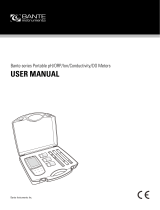Measurements
pH Measurement
1.1 Rinse the pH electrode with distilled water. Place the electrode
(and temperature probe) into the sample solution and stir gently.
Note, the pH-sensitive glass membrane and liquid junction must
be completely immersed into the solution.
1.2 If the Auto-Hold option in the setup menu is enabled, the meter
will automatically sense a stable reading and lock measurement,
the icon appears on the display. Press the Meas key to resume
measuring.
If the option is disabled, the meter will continuously measure and
update the readings.
1.3 Wait for the measurement to stabilize and record the reading.
1.4 When all of the samples have been measured, rinse the electrode
according to the instructions in the Electrode Maintenance.
• During the measurement process, never wipe the pH-sensitive
membrane as this will cause static interference, blot dry with a
lint-free tissue to remove waterdrops on electrode.
• If the meter shows ---- indicating the measurement exceeds the
range, remove the electrode from the sample immediately.
• If your sample is pure water, low ionic or low conductivity water,
we recommend measuring the pH in the smallest sample volume
possible or adding 0.3 ml of the 3M KCl to 100 ml of the sample
solution. Note, only high purity KCl can be used.
mV Measurement
2.1 Press the Mode key to switch the meter to mV mode.
2.2 Rinse the electrode with distilled water. Place the electrode into
the sample solution and stir gently. Record the reading when the
measurement is stable.
Electrode Maintenance
Cleaning the pH Electrode
Since pH electrode is susceptible to contamination, thoroughly clean
as necessary after each use.
• General Cleaning
Rinse the pH electrode with distilled water and soak in 3M KCl
solution.
• Salt Deposits
Dissolve the deposit by immersing the electrode in warm tap
water. Rinse the electrode with distilled water and soak in 3M
KCl solution.
• Oil or Grease
Place the electrode in the detergent or ethanol solution for 15
minutes. Rinse the electrode with distilled water and soak in 3M
KCl solution.
• Protein
(1) Add 1% pepsin to 0.1M HCl solution.
(2) Place the electrode in above solution for 15 minutes.
(3) Rinse the electrode with distilled water and soak in 3M KCl
solution.
• Clogged Liquid Junction
(1) Heat a diluted KCl solution to 60° C (140° F).
(2) Place the electrode into the heated solution for 10 minutes.
(3) Allow the electrode to cool in unheated KCl solution.
Reactivating the Electrode
If the pH-sensitive membrane has dried out, the electrode response
will become sluggish. Immerse the electrode in a pH 4.01 buffer
solution for about 30 minutes to rehydrate. If this fails, the electrode
requires activation.
1. Soak the electrode in a 0.1M of HCl for 10 minutes.
2. Remove and rinse with distilled water, then place into a 0.1M of
NaOH for 10 minutes.
3. Remove and rinse again, and soak in 3M KCl solution for at least
6 hours.
If these steps fail to restore the response, replace the electrode.
Storing the Electrode
• For best results, always soak the electrode in 3M KCl solution.
• If above solution is not available, use a pH 4.01 buffer solution.
• DO NOT store the electrode in distilled or deionized water that
will deplete the hydration layer of the pH-sensitive membrane
and render the electrode useless.
• If you do not use the electrode for a period longer than 1 month,
store the electrode in storage solution.




















